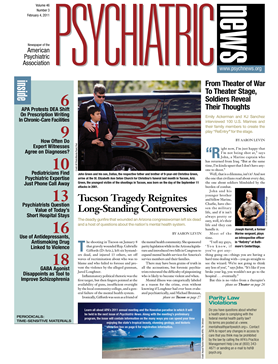The shooting in Tucson on January 8 that gravely wounded Rep. Gabrielle Giffords (D-Ariz.), left six bystanders dead, and injured 13 others, set off waves of recrimination about who was to blame and who failed to foresee and prevent the violence by the alleged gunman, Jared Loughner.
Inflammatory political rhetoric was the first target, but then fingers pointed at the availability of guns, insufficient oversight by the local community college, and a general failure of the mental health system.
Ironically, Giffords was seen as a friend of the mental health community. She sponsored parity legislation while in the Arizona legislature and introduced two bills in Congress to expand mental health services for America's service members and their families.
There may have been grains of truth in all the accusations, but forensic psychiatrists reiterated the difficulty of pinpointing who is likely to become violent and when.
Mental illness was categorically labeled as a reason for the crime, even without knowing if Loughner had ever been evaluated psychiatrically, said Michael Brennan, M.D., president of the Arizona Psychiatric Society. “I'm concerned that this event will add to the false idea that people with mental illness are homicidal individuals.”
Brennan offered the services of the society's members to the Tucson community after the tragedy.
APA President Carol Bernstein, M.D., offered her condolences as well.
Such violent events extend into communities beyond the immediate victims and witnesses, Bernstein noted in a statement. Individuals who have contact with vulnerable persons should be cautioned about possible overexposure to media reports and should support those who need help coping, she said.
Psychiatrists at Tucson's University Medical Center where many victims, including Giffords, were taken for treatment, were among the first of the local community to respond to the shootings, said Brennan.
Hospital psychiatrists, psychologists, and other staff members provided care for “people touched by the incident, from very close to more remote, including first responders and hospital personnel,” said Francisco Moreno, M.D., a professor and interim head of the Department of Psychiatry at the University of Arizona College of Medicine.
Moreno's department is part of a trained institutional critical-incident stress-management team that includes the FBI, the U.S. and Arizona attorneys general's offices, the Pima County sheriff, and the University of Arizona, he said in an interview.
Like the rest of the hospital, the psychiatry department reacted by immediately providing a quick intake service while keeping other services unaffected as much as possible.
“We asked all our clinical providers to open additional intake appointment times dedicated only to people involved in the tragic incident,” said Moreno. “People came in early or stayed after hours, worked over the Martin Luther King holiday, and shifted times assigned to research or administrative activities in order to have special availabilities for these patients.”
Staff members saw people directly affected by the event, members of their families, and people not at the scene for whom the incident triggered preexisting psychiatric problems, he said.
Members of the university's psychiatry department also met to describe and coordinate best practices for posttrauma care, he said. They prepared handouts for clinicians and patients, with a version to be disseminated through the local media to “benefit the larger community and enhance resilience.”
Outpatient Commitment Hard to Obtain
Whether Loughner's behavior prior to January 8 was sufficient to require confinement became subject to widespread speculation after the tragedy.
“He appears to be a troubled young man, but there are a lot of troubled young people, odd in appearance or dress, some using drugs that may mimic mental illness or its early stages, but most are not going to commit violent acts,” said Paul Appelbaum, M.D., the Elizabeth K. Dollard Professor of Psychiatry, Medicine, and Law and director of the Division of Law, Ethics, and Psychiatry in the Department of Psychiatry at Columbia University College of Physicians and Surgeons. “It's a needle-in-a-haystack situation.”
Arizona law is unusual in that it allows a fourth criterion to the three typically used for involuntary civil commitment in most states. The statute lists being a danger to self or to others or being “gravely disabled” (unable to care for oneself) as grounds for commitment. The state also allows commitment for the “persistently or acutely disabled,” a term that covers those with a severe mental disorder along with impaired judgment and capacity to understand or comply with treatment options.
However, this fourth criterion is not a quick solution for getting people out of the community, as some have suggested, said Barry Morenz, M.D., an associate professor of clinical psychiatry and director of forensic psychiatry at the University of Arizona College of Medicine.
“The process takes three days to a week to carry out,” said Morenz in an interview. “For example, it is often used by families to get a family member who is not in treatment and getting worse into inpatient and then outpatient treatment.”
The provision was not invoked in Loughner's case, so far as is known. Some psychiatrists think it should have been used.
“[I]f a school or business community is so fearful for its safety that it evicts one of its own, it is clear that a serious threshold of concern has already been reached,” wrote psychiatrists Jeffrey Geller, M.D., and Sally Satel, M.D., in an editorial in the January 18 USA Today. “A requirement for mandatory reporting at that stage might prevent some tragedies with only minimally greater intrusion on an individual's rights than is now permitted.”
Such reporting would lead to an evaluation, which might possibly require involuntary treatment, they wrote.
Enacting laws making involuntary civil commitment easier are not enough, said Robert Bernstein, Ph.D., executive director of the Bazelon Center for Mental Health Law, in a statement.
“The fact that Arizona has had such laws in place for many years points to the hollowness of these solutions,” said Bernstein. “America's mental health care system is horribly broken and horribly underfunded. . . . The nation's system of community mental health care, now struggling to provide even late-stage crisis services, should be equipped to ensure that early, effective assistance is available to people who need it.”
Increasing use of civil commitment might get people with mental illnesses off the streets, but doesn't address the question of what happens to them next, said Morenz.
“The challenge is that funding for care of seriously mentally ill people in Arizona now is fairly poor, so getting people into treatment is difficult,” he said.
In 2010, Republican Gov. Jan Brewer reduced state funding for the Department of Health Services by half, cutting services to about 14,000 mentally ill Arizonans, according to the Los Angeles Times. The 2011 budget also changes eligibility for Medicaid in the state, potentially eliminating servicers for 5,000 mentally ill patients.
Not only is access poor, but treatment is “not robust” in the state system, said Morenz. Patients may receive medications but don't get into therapeutic settings, there is little follow-up supervision, appointments are spread out too far apart, and many patients drop out of treatment, he said.
College Makes Easy Target
After the initial response to the tragedy, the media focused attention on the role of Pima Community College, where Loughner was a student from 2005 until October 2010.
Pima Community College released material documenting reports by college professors, students, officials, and campus police describing Loughner as “very hostile” and “creepy.”
From February to September of last year, college police were called on five occasions to deal with Loughner regarding classroom and library disruptions.
The college suspended him on September 29, 2010. Loughner and his parents met college administrators on October 4, 2010, when he agreed to withdraw.
“A follow-up letter was sent to him on October 7, 2010, indicating that if he intends to return to the college, he must resolve his Code of Conduct violations and obtain a mental health clearance indicating, in the opinion of a mental health professional, his presence at the college does not present a danger to himself or others,” said a statement on the college Web site.
Requiring such clearance as a condition of return is now standard procedure at colleges and universities, said Jerald Kay, M.D., co-editor with Victor Schwartz, M.D., of Mental Health Care in the College Community, in an interview.
Pima Community College offers counseling services to help students with “educational, career, and personal concerns” and can refer them to community agencies when needed, according to its Web site.
That is typical of community colleges, which vary widely in the counseling services they provide, said Norma Kent, senior vice president for communications and advancement at the American Association of Community Colleges in Washington, D.C.
“Virtually all have counselors, although most do not have psychologists on staff,” she told Psychiatric News. “Community colleges think therapy is beyond their charge, but they can identify [outside] professional resources to which they refer students.”
So far as is known publicly, the college did not advise Loughner to seek treatment. The college declined to provide information on that point when asked by Psychiatric News. The institution was also criticized in the media for not petitioning authorities for his civil commitment, even if the college met the letter of the law in the manner of Loughner's dismissal and the terms set for his reinstatement.
Just what is a college's responsibility to act when a student acts inappropriately?
“A college can be reasonably expected to notice something is wrong, to make a suggestion to seek help, and to do what is necessary to protect other students and staff,” said Appelbaum. “It looks like the college did all three. What we don't know is how well the college did all these things.”
How easily college administrators or mental health personnel can recognize potentially dangerous students is also uncertain, experts agreed.
“Colleges and universities are places where heterogeneous behavior is encouraged and a broader range of behavior is acceptable,” said Victor Barr, Ph.D., staff psychologist and director of the counseling center at the University of Tennessee–Knoxville, in an interview. Barr serves on the governing board of the Association for University and College Counseling Center Directors.
Somewhere in that broad range lies an often murky boundary between an individual's rights and society's safety, as the nation was reminded, once again, on January 8.

